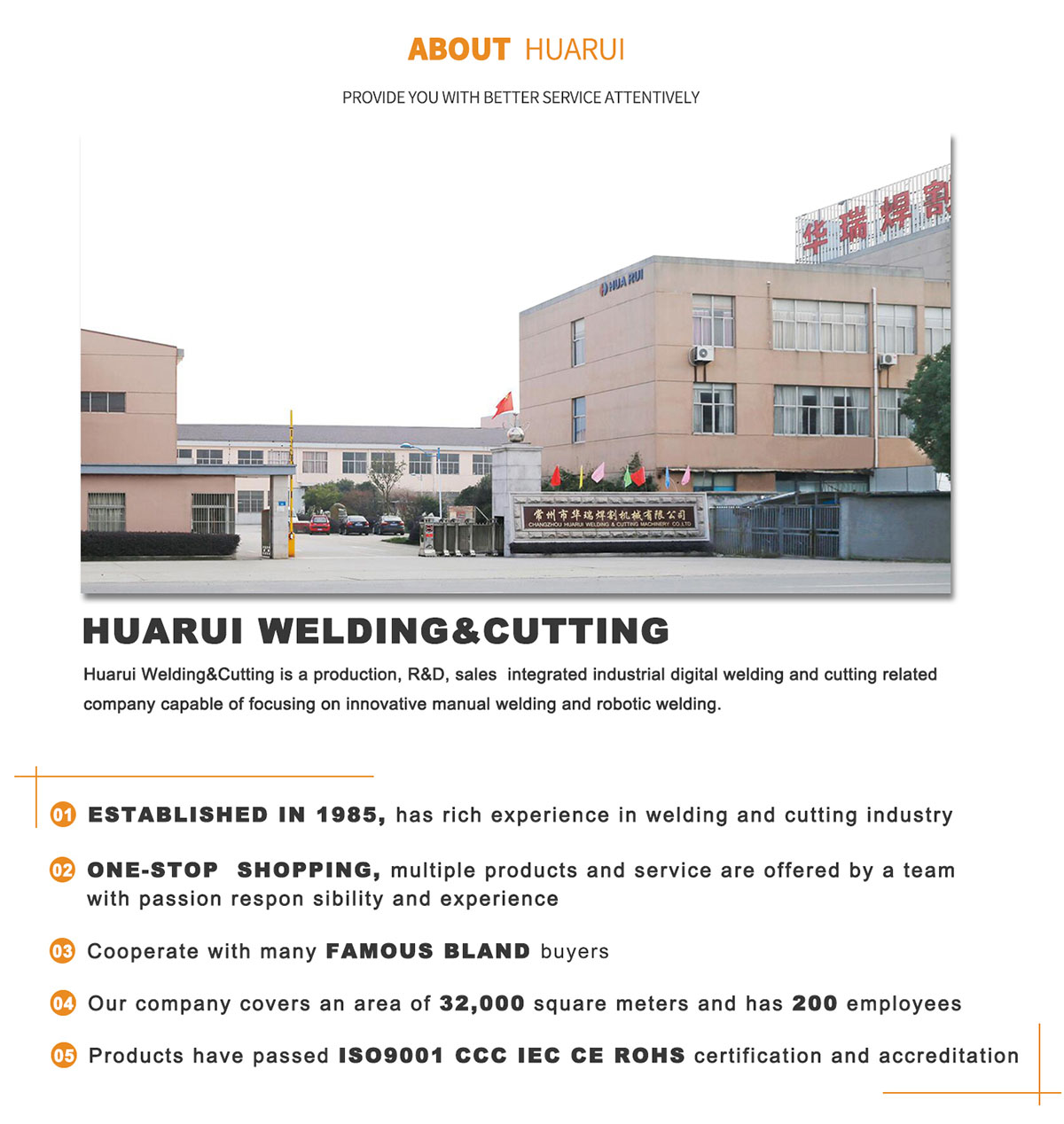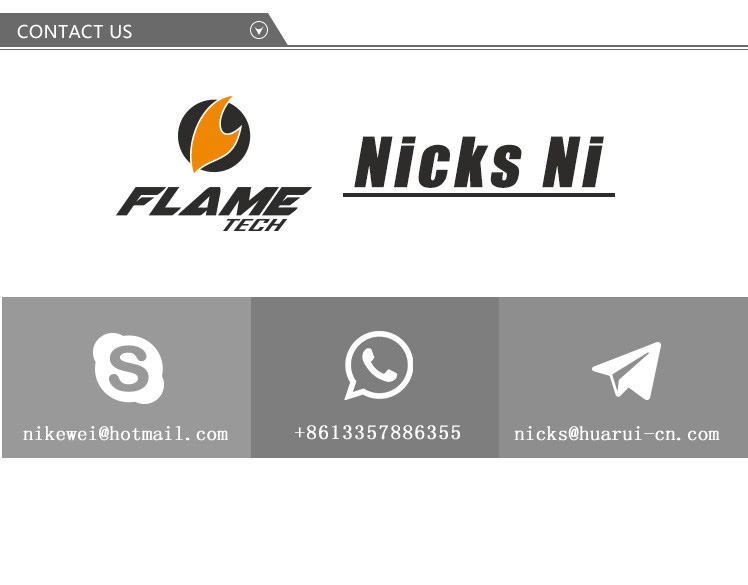- Welcome To Changzhou Huarui Welding & Cutting Machinery Co., Ltd.!
- About Huarui | Inquiry Form | Contact Us |
 中文
中文
 中文
中文About spot welder Contact welder electrode material composition
1, CuCr (chromium copper) and CuCrZr (chromium zirconium copper) What is the difference?
Common ground: all are copper alloy material, suitable for resistance welding electrode, with high hardness, strength; It has the characteristics of high temperature softening, can resist high temperature and maintain its chemical and physical properties at about 450℃ ~ 550℃; With certain wear resistance, long service life; It has good electrical conductivity.
Difference: In copper alloy smelting, CuCr only adds Cr element to copper; CuCrZr, in addition to adding a certain component of Cr element, also added Zr element, and Zr element has wear resistance, toughness and other characteristics, so CuCrZr compared with CuCr, the material has better wear resistance, has a longer service life, but also improve the high temperature softening temperature, so CuCrZr as an electrode material is more superior.
2. Why does the electrode stick when welding the galvanized sheet?
This is because the electrode material used is CuCr or CuCrZr, when the Cu in the material is welded to produce high temperature melting, the zinc (Zn) of the galvanized plate will react with Cu and Zn alloy, and CuZn is just the brass alloy composition, and a chemical reaction occurred, the loss of the electrode material, resulting in the phenomenon of sticking.
3, how to solve the bonding phenomenon when welding galvanized sheet?
a) The best solution is to use dispersion strengthened copper (CuAl2O3),CuAl2O3 is a superior resistance welding electrode material, its softening temperature is up to 900°, is a good electrical conductivity strength and wear resistance, long service life, does not produce electrode and workpiece sticking phenomenon.
b) If you want to use CuCr or CuCrZr, you can use two current welding method, spot welding machine must have two current output, the first current (small) will first break down the coating, the second current to weld the workpiece, so that the workpiece will be firmly welded, the electrode sticking phenomenon will also be improved.
4, what is KCF, why welding nuts, bolts to use it?
KCF is a special ferrochrome alloy, which is characterized by good hardness and strength toughness, and after special heat treatment process, it has the characteristics of low pressure insulation on the surface, and when welding nuts or bolts, the thread part is required to make insulation protection to prevent the burn of the screw due to shred; Because KCF is used as a bar forming material, the processing is more convenient and the cycle is shorter; Therefore, it is ideal to use KCF material as the positioning core.
Of course, ceramic materials can also be used as the positioning core, the hardness of ceramics is completely no problem, but because it is easy to break and break, it is not ideal, and the molding needs a mold, so the processing of special cores is more difficult, the production cycle is longer, and the cost of small batches is very high. If the batch is large and standardized, the cost will be lower.
5, electrode material introduction:
Chromium-zirconium copper (CuCrZr)
Chromium zirconium copper (CuCrZr) is the most commonly used resistance welding electrode material, which is determined by its excellent chemical and physical properties and good cost performance.
1) Chrome-zirconium copper electrode It achieves a good balance of the four performance indicators of the welding electrode:
Excellent electrical conductivity ---------- ensures the minimum impedance of the welding circuit and achieves excellent welding quality.
High temperature mechanical properties ---------- High softening temperature guarantees the performance and life of electrode materials under high temperature welding environment.
Wear resistant ---------- electrode is not easy to wear, prolong life, reduce costs?
High hardness and strength ---- ensure that the electrode head under a certain pressure is not easy to deformation and crush, to ensure the welding quality.
Instructions:
1) Chemical composition analysis of the alloy according to ZBH62-003.1-H62003.8;
2) The hardness of the alloy is measured according to GB230, and the average value is taken at three points for each sample;
3) Eddy current conductance meter for conductivity measurement (eddy current comparison method). Each sample is measured at three points, and its average value is taken. Samples with a diameter less than 15mm can be measured according to GB3048.2;
4) For softening temperature test, the sample is placed in the furnace with the temperature rising to 550℃ (after closing the furnace door, it is required to return to this temperature for 2h within 15Min and then quench water cooling, and the temperature value of the sample room is measured (taking the average value of three points).
5) Electrode is an industrial production of consumables, the amount is relatively large, so its price and cost is also an important factor to consider, chromium zirconium copper electrode relative to its excellent performance, the price is relatively cheap, can meet the needs of production.
6) Chromium-zirconium copper electrode is suitable for spot welding and convex welding of carbon steel plate, stainless steel plate, plated plate and other parts, chromium-zirconium copper material is suitable for manufacturing electrode caps, electrode connecting rod, electrode head, electrode grip, convex welding special electrode, welding wheel, conductive nozzle and other electrode parts.
Beryllium copper (BeCu)
Beryllium copper (BeCu) electrode material has higher hardness (up to HRB95~104), strength (up to 800Mpa/N/mm2) and softening temperature (up to 650℃) than chromium-zirconium copper, but its conductivity is much lower and poor. Beryllium copper (BeCu) electrode material is suitable for welding under high pressure sheet parts, as well as harder materials, such as welding wheels for welding seams; It is also used for some electrode accessories with high strength requirements, such as crank electrode connecting rod, converter for robots; At the same time, it has good elasticity and thermal conductivity, and is suitable for manufacturing stud welding collet. Beryllium copper (BeCu) electrodes are expensive, and we usually list them as special electrode materials.
Copper alumina (CuAl2O3)
Copper aluminum oxide (CuAl2O3) is also known as dispersion strengthened copper, it compared with chromium zirconium copper, has higher strength (up to 600Mpa/N/mm2), excellent high temperature mechanical properties (softening temperature of 900℃) and good electrical conductivity (conductivity 80~85 IACS%), with excellent wear resistance, long life. Copper aluminum oxide (CuAl2O3) is a kind of excellent performance electrode material, whether its strength, softening temperature or conductivity are very superior, especially for welding galvanized sheet, it does not produce the phenomenon of electrode and workpiece sticking as chromium zirconium copper electrode, without frequent grinding, effectively solve the problem of welding galvanized sheet, improve efficiency, reduce production costs. Aluminum oxide copper electrode has excellent welding performance, but its current cost is very expensive, so the current use can not be widely used, but the excellent welding performance of galvanized sheet and the widespread use of galvanized sheet, making its market prospects. Aluminum oxide copper electrode is suitable for welding of galvanized steel plate, aluminum products, carbon steel plate, stainless steel plate and other parts.
Tungsten (W), Molybdenum (Mo)
Tungsten electrode materials are pure Tungsten, tungsten-based high-gravity alloy, and tungsten-copper alloy. Tungsten-based high-gravity alloy is sintered by adding a small amount of nickel-iron or nickel-copper to tungsten, and tungsten-copper composite materials contain 10-40% Copper by weight.
Molybdenum tungsten electrode has high hardness, high melting point, high temperature performance and other characteristics, suitable for welding non-ferrous metal copper, aluminum, nickel, such as the switch of copper braided strip and metal sheet welding.
Appendix: Chemical and physical properties of electrode materials
1) Chromium-zirconium copper (CuCrZr) molding process:
Vacuum melting → hot forging (extrusion)→ solid melting → cold forging (drawing)→ aging treatment
The above process, coupled with strict quality control, ensures excellent electrical conductivity, high strength and good wear resistance of the material.
The standard electrode head, electrode cap and shaped electrode are produced by cold extrusion process and precision machining to further improve the density of the product, and the product performance is more excellent and durable to ensure stable welding quality.
Round rod specifications φ3.0 ~45mm, the box or disk is generally forged according to the requirements of customers.
Chemical composition and physical properties of Al 2 O 3 Cu and BeCu

HUARUI alibaba shop:
https://topwelding.en.alibaba.com
https://czhuarui.en.alibaba.com


 master@huarui-cn.com
master@huarui-cn.com 86-519-86371071
86-519-86371071 86-519-86371072
86-519-86371072
View More(Total0)Comment Lists